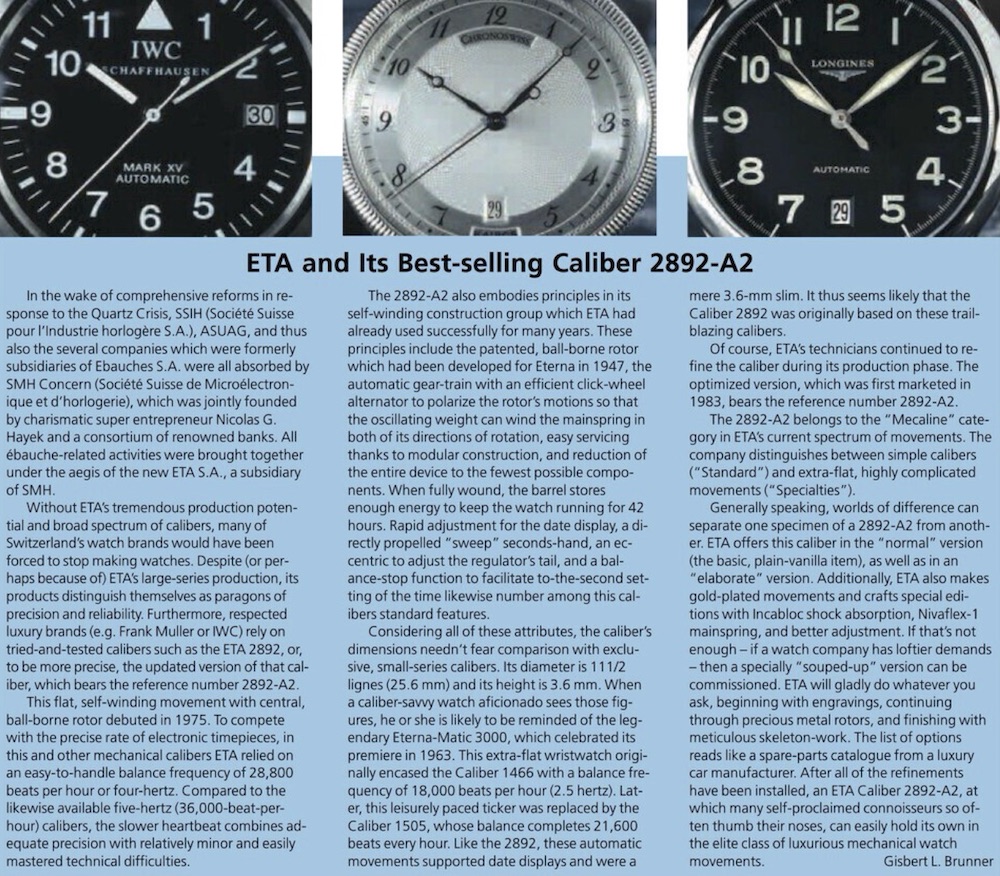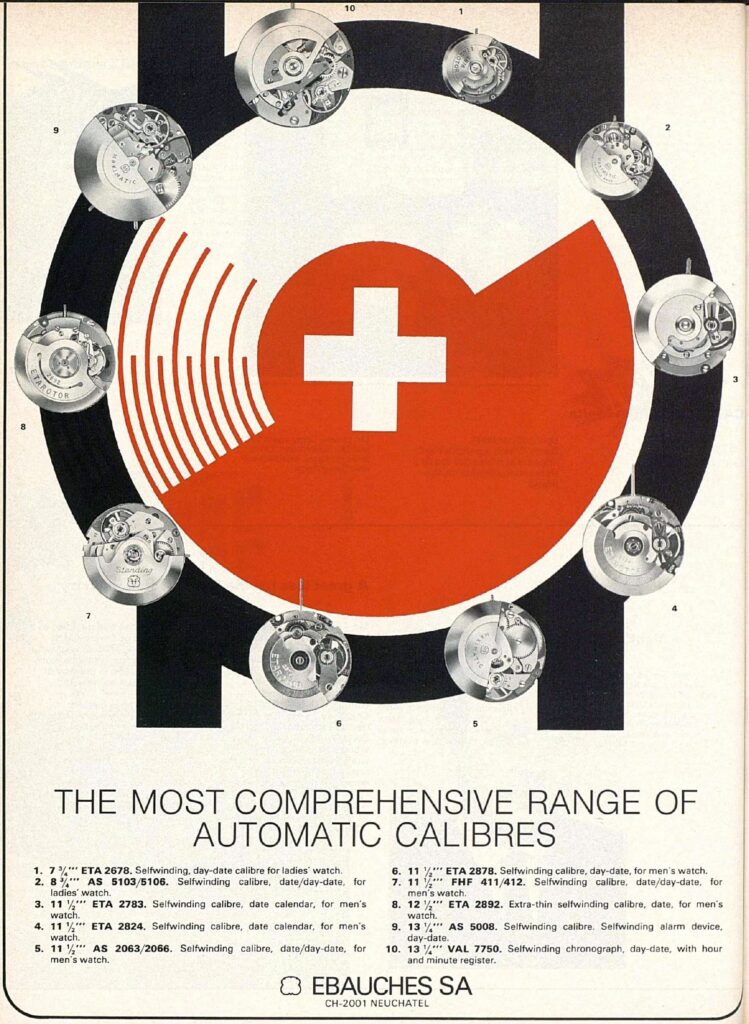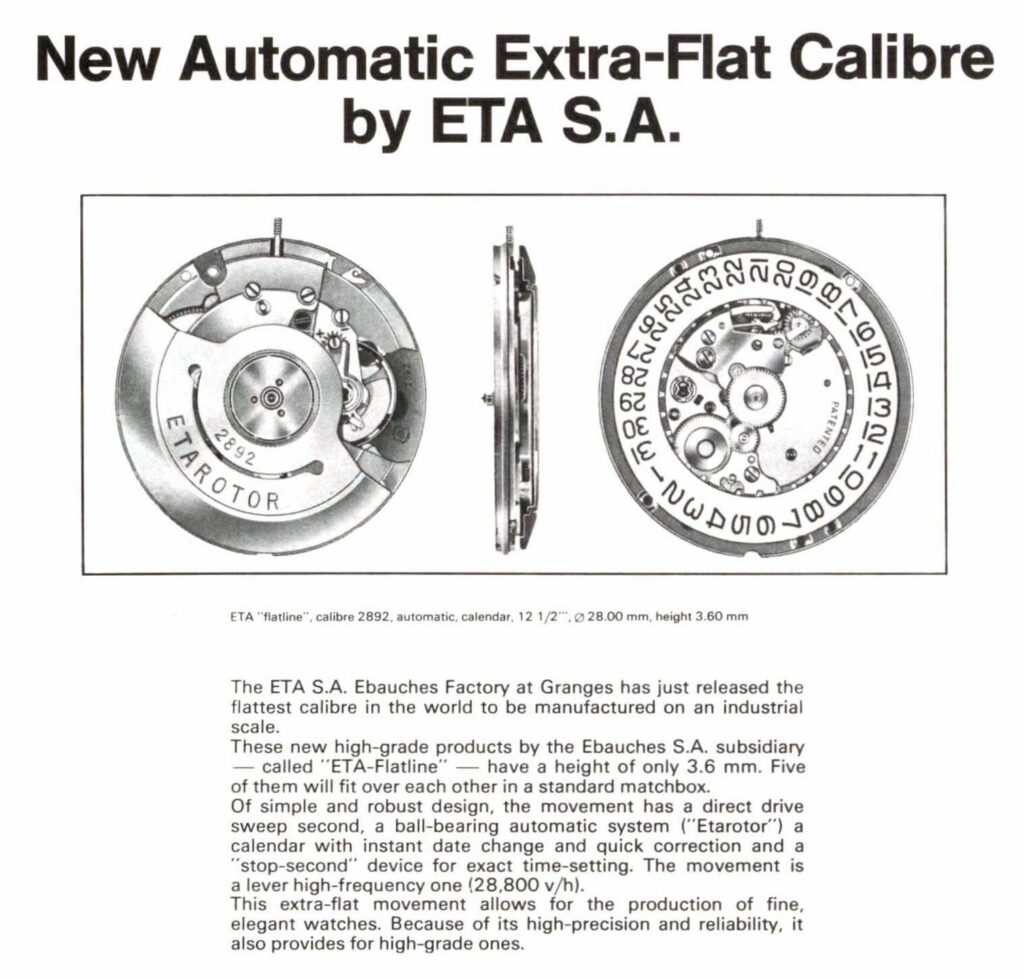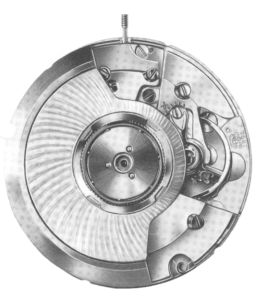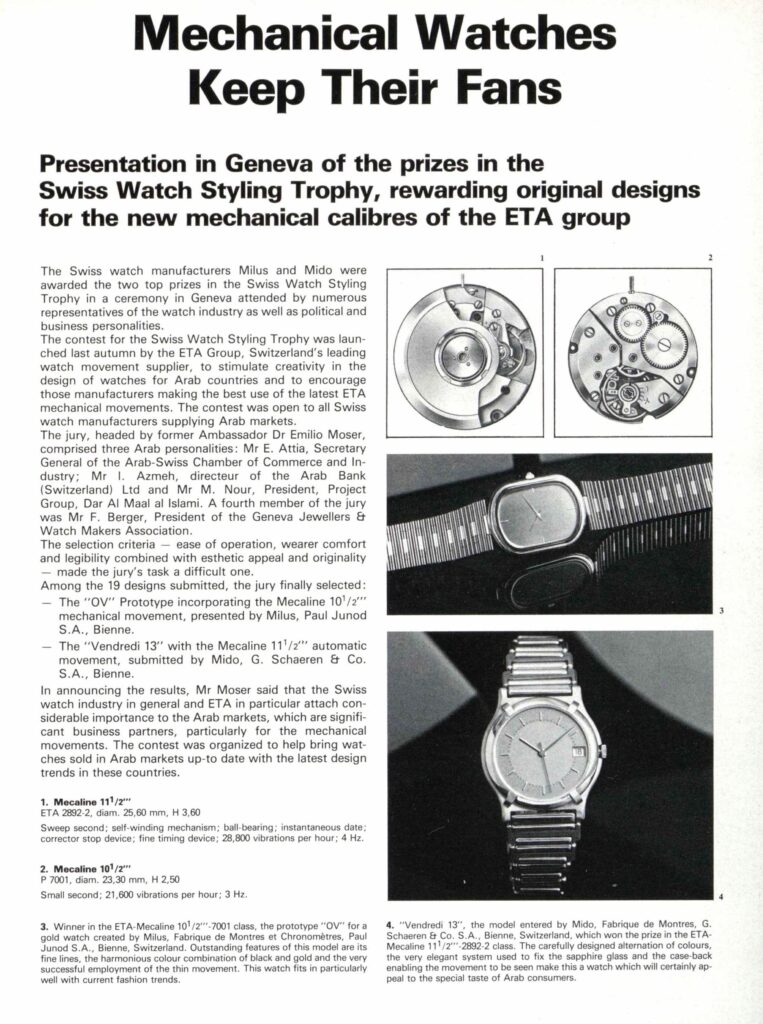When ETA names a movement, they usually use the last digit or two to signify added functions, then a numeral after a dash to indicate an update. Cal. 2892-2 was an update to Cal. 2892, and that movement added a date complication to Cal. 2890. But this isn’t how it works for ETA’s “Travel Time Trio”, Cal. 2893-1, 2893-2, and 2893-3. These were introduced together in 1992 and represent variations on one complication rather than updates.
Learn all about the ETA 2890 Family, including the 2893 Trio
ETA’s 2892: Evolving Eterna’s Thin Movement
If the ETA 2824-2 is a Volkswagen, the ETA 2892A2 is an Audi: Both are good, but one is decidedly more upscale. Last week I presented the timeline for the ETA 2890 family, checking it for accuracy against primary sources. The original Cal. 2892 was introduced as a thin 3.60 mm 12.5 ligne movement in 1975 and was replaced by a 11.5 ligne derivative around 1983. Although the transition from Cal. 2892-2 to today’s Cal. 2892A2 is a bit fuzzy, we can surely say that it came in the 1990s and that today’s watches universally use the latter, with its updated winding system and better finishing.
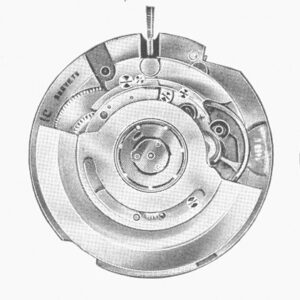
These movements were initially intended to be used as-is in thin watches. Cal. 2892 was derived from Eterna’s Cal. 1466, a legendary movement from 1962 that was used in the thinnest automatic watch with date at the time. Designed by Heinrich Stamm, this movement was used throughout the 1970s in higher-end thin luxury watches. One of the most famous of these was the Eterna-Matic 3000, a name that has come to be used to refer to the entire movement family. But these movements were not as reliable as hoped.
Contrary to popular folklore, every one of these movements had seven ball bearings supporting the rotor, the time-only and date versions were the same 3.60 mm thickness of the 2892, and the final movement, Cal. 1504, operated at 28,800 A/h as well. Eterna even made 12.5 ligne versions, though most were 13 ligne.

Cal. 2890 and 2892 were a total redesign of the Eterna movement. The task was taken up by Anton Bally, who would also work on the first generation of Flatline Quartz movements for ETA, the ultra-thin Delirium, and would eventually succeed Ernst Thomke as managing director of ETA. Looking at images of the two movements, it is as obvious that they are related as it is that they are different. The bridges are entirely different, with many components relocated and “beefed up” for reliability and ease of manufacture and servicing.
Cal. 2892 was the basis for a new initiative at ETA, the “Flatline” movements. These were created by Bally and his team, and included quartz movements based on the Cals. 2890 and 2892, Cals. 940.101 and 940.111, which were introduced in 1976. This line was soon expanded with more thin quartz and mechanical movements and were used in a wide variety of watches around 1980. But all of these watches shared a similar characteristic: They were thin and uncomplicated.
ETA’s 2892A2: A Platform for Complications
ETA’s movements saved the Swiss watch industry. The Swatch project generated much-needed volume and market share, the Delirium gave new prestige in quartz, and the quartz Flatline series was used in the vast majority of Swiss watches produced in the 1980s. At the same time, Günter Blümlein of IWC and Jaeger-LeCoultre saw complicated mechanical movements as path forward for the industry. IWC began this push in 1985, often using the chunky Valjoux 7750 as a basis.
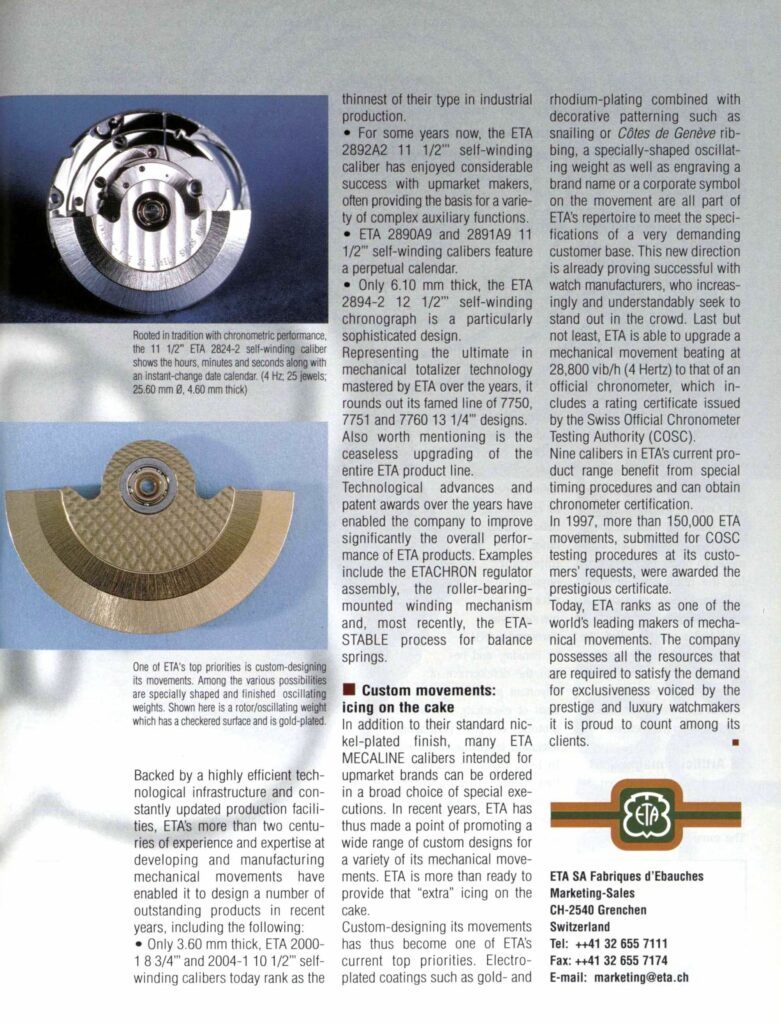
Image: Europa Star 231, 1998
ETA would eventually build a popular automatic modular chronograph on the 2892-2 base, but first came the perpetual calendar Cal. 2890-9 and 2891-9 and the “Travel Time Trio” known as the Calibres 2893. These feature an adjustable 24-hour function to be used as a hand or disc, added to the dial side of the basic Cal. 2892-2 or Cal. 2892A2. More about them in a moment.
Complication maker Dubois Dépraz began producing modules to add to a Cal. 2892-2 base in the 1980s and these became popular with the rise of complicated watches. Soon, the thin 2892-2 was serving as a platform for complications rather than being the focus on its own.
The first such movements were the original perpetual calendar Cal. 2890-9 and Cal. 2891-9. These were clearly based on the original Cal. 2892-2 rather than the updated Cal. 2892A2, since they were updated and renamed as Cal. 2890A9 and 2891A9. But it is unclear when they first appeared, and very few watches appear to have used them.
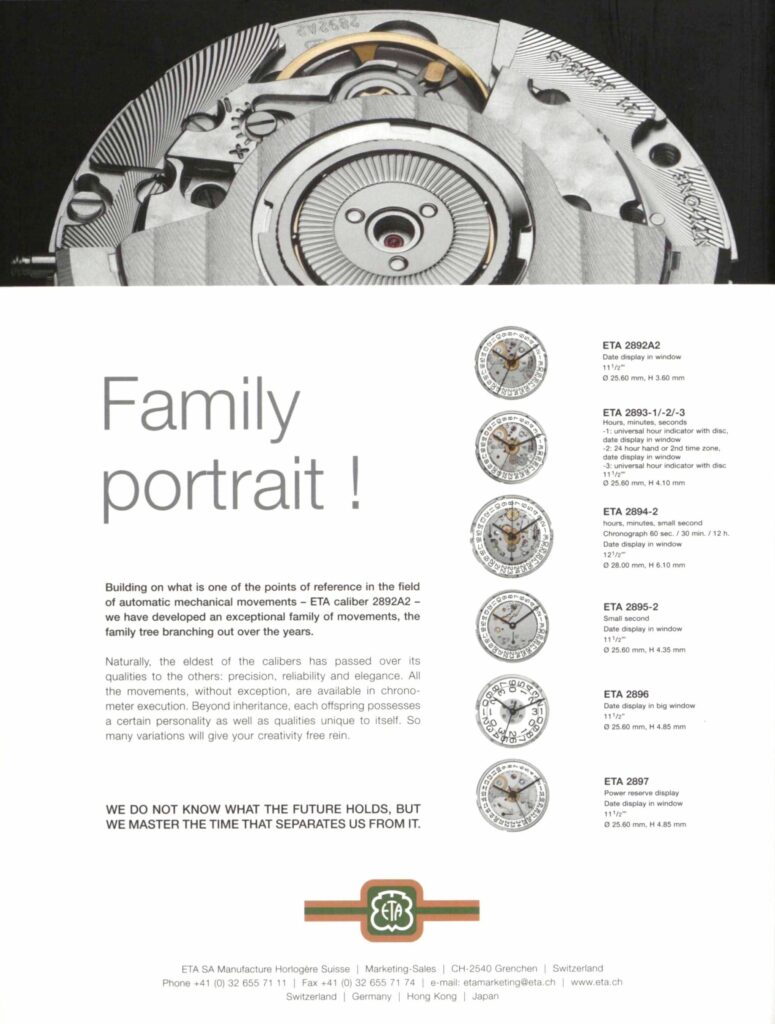
ETA 2893 Movements
ETA released a trio of dual time zone movements in 1992, all known as Cal. 2893. Each movement has a slightly different implementation of a 24 hour second time zone display.
| Date | No Date | |
| 24 Hour Disc | ETA 2893-1 | ETA 2893-3 |
| 24 Hour Hand | ETA 2893-2 |
In all three movements, the central 24 hour display is quick-set using the crown in second position and is independent of the central hour hand, which is set using the crown in third position. Adjusting the 24 hour hand or disc does not cause the movement to “hack” or stop, so the timekeeping remains accurate when traveling.
Although common today, an independent hour hand like this was somewhat unusual at the time. Indeed, the popular Rolex GMT-Master II Ref. 16710 had just gained an independently-adjustable 12-hour hand four years earlier.
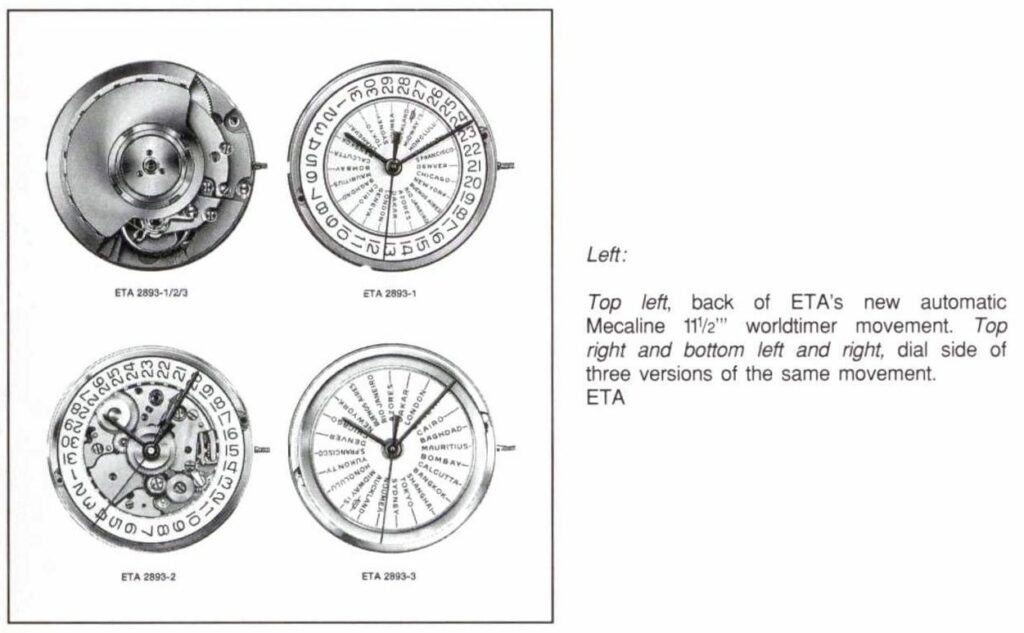
Image: Europa Star 193, 1992
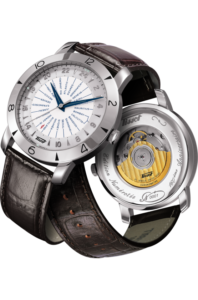
Image: © Tissot
The rotating city disc found on the 2893-1 and 2893-3 is reminiscent of the famous Tissot Navigator, introduced in 1952 though now considered to be a 1953 model. Most ETA movements found their first home inside Tissot or Longines watches at this time, since both companies were closely related to ETA and indeed Anton Bally was particularly involved with Tissot at the time. He had created a Flatline III quartz movement for a new Tissot Navigator in 1985, and it should come as no surprise that Tissot introduced a new automatic Navigator using Cal. 2893-3 in 1995. This would also be one of the signature models for Tissot’s 160th anniversary in 2013.
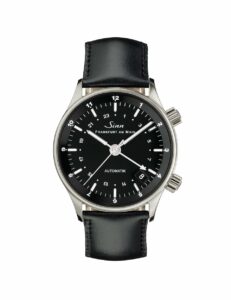
Image: © Sinn
The Cal. 2893 trio remain in production, but are quite rarely seen. They are often confused for one another, especially the two world time disc movements, and can be quickly interchanged with just a few parts swapped. Famous watches with these four-hand GMT Cal. 2893-2 include the Ikepod Seaslug, Panerai Luminor GMT (PAM 023, 029, and 063), Fortis Spacematic GMT, Hamilton Khaki Navy GMT, Montblanc Time Walker GMT, Sinn U2 and UTS and Frankfurt 6036 and 6060, the modern Bulova “Accutron” Astronaut, and Glycine’s Airman. More unusual are the Magellan 1521 with its huge bubble dial and crystal, the Arnold & Son True Moon’s 24 hour moon phase display, and the truly strange triple-movement Glycine Airman 7. Among those to use Cal. 2893-1 are Anonimo’s Dino Zei Aeronauta. The Meistersinger Adhaesio appears to use a modified Cal. 2893 as well.
Research Notes: ETA 2893

Image: EJW 10, 1952
The image reproduced above shows the complete ETA 2893 lineup in 1992. This is clearly an announcement of introduction and definitively sets this as the date that these movements first appeared. This was before the first mention of the modern ETA Cal. 2892A2, but today’s ETA Tech Sheets show these movements sharing key components, including the oscillating weight. This lends credence to my theory in the previous article that these differences were implemented over time and retroactively named, rather than being a true model change-over.
ETA’s Tech Sheets also show that the difference between each 2893 movement lies in the main plate and the components attached to it on the dial side. Each movement (2893-1, 2893-2, and 2893-3) has a different main plate but many other components are shared. A spacer ring is used on the outer diameter to make room for these dial-side components.
The earliest use of any Cal. 2893 movement that I could locate was the Ikepod Seaslug. The rather unusual lug-less sloping case and the fact that famous designer Marc Newson was responsible is perhaps overshadowed by the unappetizing name! This model gained attention in Europa Star in 1995, 3 years after the 2893 trio were released.
The famous Tissot Navigator is described in detail in Eastern Jeweller & Watchmaker number 10, which was published around April 1952. This is notable because nearly every source places the introduction of this iconic watch in 1953, including Tissot, which commemorated its 60th anniversary in 2013. Strangely, the company also appears to have skipped the 40th anniversary of this model, waiting until 1995 to release the (limited edition) automatic Navigator even though ETA’s Cal. 2893-1 was announced in 1992.
It is notable that this modular movement pre-dates most of the complicated Cal. 2892A2 derivatives, Cal. 2894-2 (the chronograph), Cal. 2895-2 (with small seconds), Cal. 2896 (with big date), and Cal. 2897 (with power reserve indicator). Only the perpetual calendar Cal. 2890-9 and Cal. 2891-9 came first.
I strongly recommend examining the following sources of information about Cal. 2893:
- “Retrospective”, Europa Star, 193, 1992
- “Seaslug by Ikepod Watch”, Europa Star 212, 1995, p. 193
- “ETA Mechanical Movements Two Centuries of Tradition”, Europa Star 231, 1998 Page 1, Page 2
- “Mister ETA”, WatchTime, December, 2002, p. 114
- “The 1521 by Magellan”, Europa Star 251, 2002, p. 32
- “Family Portrait”, Europa Star 264, 2004
- “The Little Engine that Could”, WatchTime, April, 2008, p. 123
- “Making a Move”, WatchTime, June, 2009, p. 96
